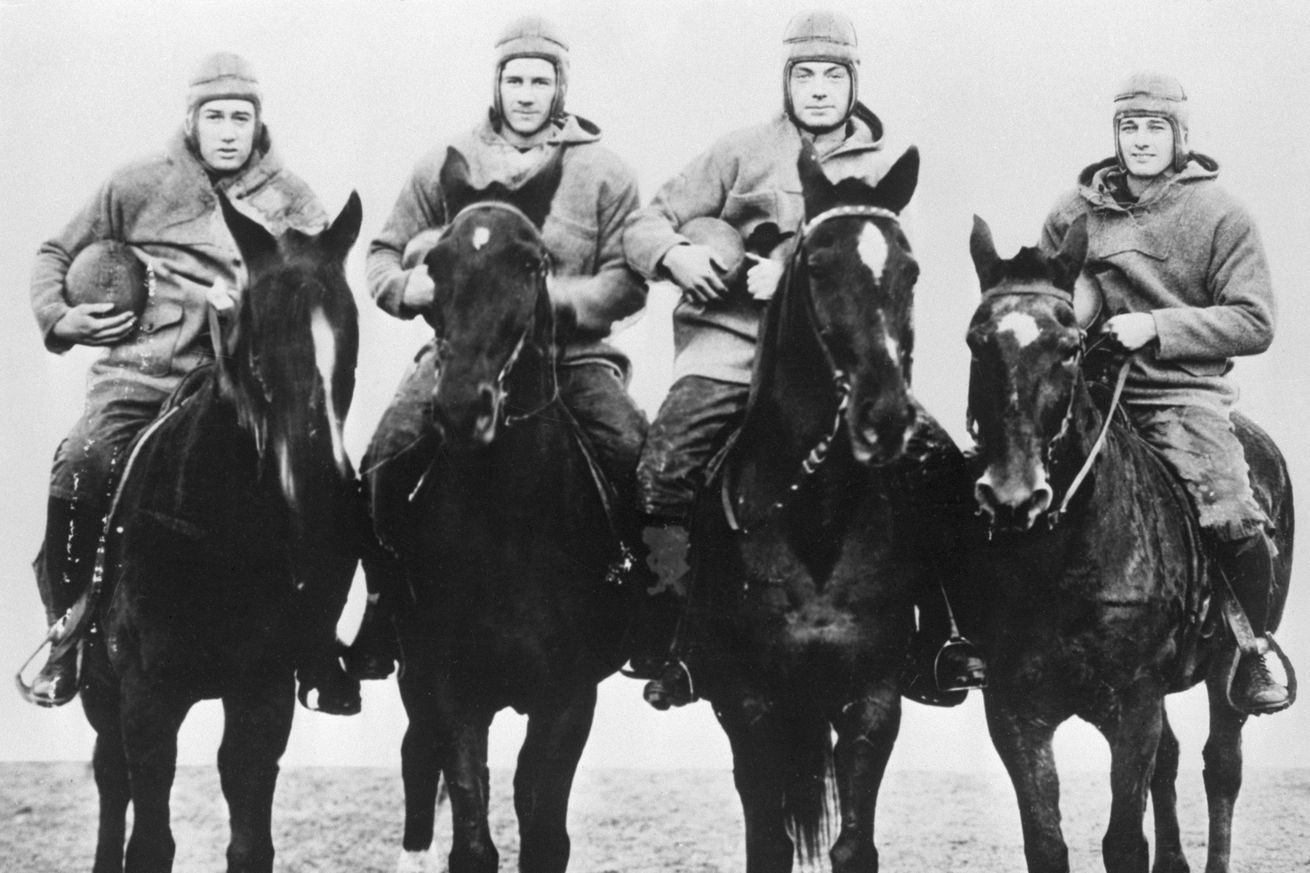
Big Crowd at Polo Grounds Sees Rockne’s Great Team Gain Decisive Victory
As we count down to the Fighting Irish of Notre Dame facing off against Army 100 years after their historic meeting at the Polo Grounds in 1924, it’s only fitting that this week’s Throwback Thursday revisits one of the most iconic games in college football history. On October 18, 1924, Knute Rockne’s Notre Dame squad faced Army in front of 60,000 spectators in New York City. This matchup, etched in the annals of football lore, was more than just a game—it was a showcase of grit, precision, and the poetic athleticism of Notre Dame’s backfield. The “Four Horsemen,” immortalized for their brilliance, led the charge against Army’s valiant defense, demonstrating why they would become legends. The Polo Grounds, a historic venue for so many pivotal moments in sports, bore witness that day to an epic clash between military might and football mastery. As we approach the centennial of this celebrated contest, let’s reflect on how the 1924 Notre Dame machine set the stage for a legacy that continues to inspire generations.
(The following excerpt is from New York Times, October 19, 1924, 118, accessed TimesMachine.)
Notre Dame Eleven Defeats Army, 13-7; 60,000 Attend Game
Moving with speed, power and precision, Knute Rockne’s Notre Dame football machine, 1924 model, defeated the Army, 13 to 7, before 60,000 at the Polo Grounds yesterday. The Hoosiers scored a touchdown in the second period and another in the third, and the Army’s only rebuttal was a touchdown shortly after the fourth period had begun. But at that late hour the soldiers were tired and battered, and the machine went on to win.
West Point pluck against Notre Dame’s machine was a one-sided proposition, and it was a clean-cut victory. an epic might be written about the Army’s brave stand and gallant counter attack in the final quarter; but after all it was Notre Dame which had the speed, the deception, the decisive punch, and, to boot, the coaching genius of Knute Rockne.
If an epic could be written about the Army, there was also material for sever poems in the swift, dashing play of the men from Indiana. Notre Dame’s backfield had some of the poetry of motion about it. Launched from well-concealed and deceptive positions, it swept the Army flanks, darted outside and inside the tackles and tore jagged holes in the line. When Miller and Crowley and Stuhldreher took the ball and started around the end, they ran like men inspired.
On a reduced scale the contest was another Army-Navy game. Next to the crowd that attended last year’s service classic at the Polo Grounds, the throng was the biggest in New York football history. Nearly every seat was filled.
Notables Attend Contest
It was one of the most notable of gridiron gatherings. In addition to Secretary of War Weeks, Major General Robert Lee Bullard, and other distinguished army officers, Dr. Hugo Eckener, commander of the ZR-3, watched what was probably his first American football game. In the company of Secretary Weeks, the commander of the history-making Zeppelin walked twice around the field in the third and fourth period.
There were hearty cheers for Secretary Weeks and thousands stood and craned their necks, but few recognized the medium-build man in a quiet suit of dark blue, his blond head bared, who walked with the secretary.
If Dr. Eckener came to see Notre Dame win through the air, he was disappointed. So were 60,000 others, for Coach Rockne kept his favorite weapon sheathed in the scabbard. Not more than a half dozen times during the game did he strike with his forward pass attack. Instead, he met the solders on their own ground-the level terra firma. With a relentless drive he attacked the wings, the tackles and the centre of Army’s line. The cadets were prepared for a stiff aerial bombardment, were unprepared for this offensive, and it was not until the fourth period that they learned the trick of stopping the twisting, elusive, smashing attack put on by one of the best backfields in the country. For three periods, Miller, Crowley, Layden, and Stuhldreher ripped and tore and swooped, and when the cadets finally checked the grinding machine it was too late.
The 1924 showdown between Notre Dame and Army was more than a game; it was a narrative of determination, strategy, and unparalleled athleticism. From the relentless ground attack orchestrated by Coach Knute Rockne to the spirited but ultimately overmatched Army defense, the game showcased the essence of college football at its finest. The Notre Dame “Four Horsemen”—Miller, Crowley, Layden, and Stuhldreher—etched their names into history that day, not just as players but as symbols of teamwork and brilliance. The New York Times captured the atmosphere, noting the poetic motion of the Irish backfield and the gallant stand of the Army team. As we look forward to Notre Dame and Army meeting once again, we are reminded of the enduring impact of this 1924 classic. It is not merely a memory but a cornerstone of Notre Dame’s storied football tradition—one that continues to echo through the years.
(Here is a bit more on the matchup, with excerpts from the 1924 Notre Dame Football Review.)
As we look ahead to the 2024 matchup between these two storied powerhouses, the stage is set for another unforgettable clash. Army enters the game with an impressive 9-0 record, while Notre Dame stands strong at 9-1, ready to defend their legacy against the Cadets. What do you expect from this highly anticipated meeting? Will the Fighting Irish channel the precision and power of their 1924 predecessors to dominate Army, or will we witness a nail-biting battle that comes down to the final moments? What say you? Share your predictions, thoughts, and game-day insights in the comments below—we’d love to hear from you!
Cheers & GO IRISH!
